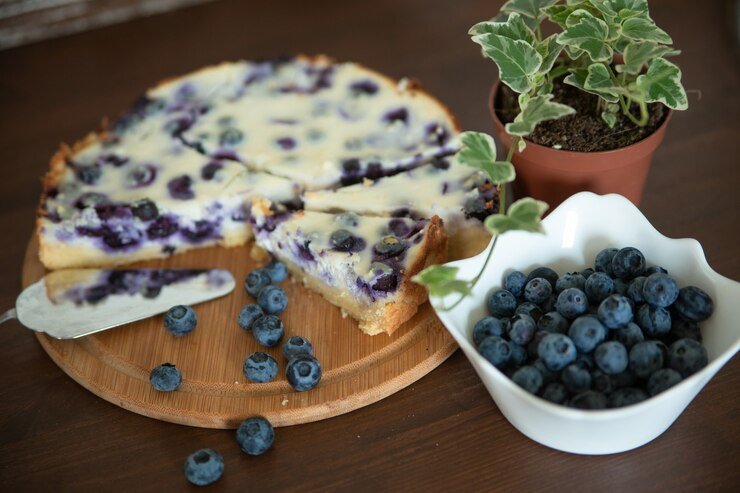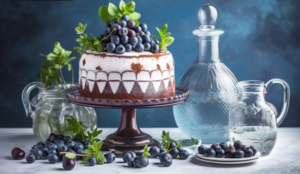Why did blueberries sink to bottom of cake and how to prevent it with expert baking tips for perfect results. Every baker faces the challenge of blueberries sinking to the bottom of their cakes. This issue impacts the cake’s appearance, texture, and flavor distribution. Our guide explores the reasons for this problem and provides practical solutions. We aim to ensure that each cake you bake is delightful in both taste and appearance.
Importance of Evenly Distributed Fruit:
Imagine slicing into a golden, fluffy cake, expecting a burst of blueberry flavor with every bite. Instead, you find that all the berries have sunk to the bottom. This uneven distribution detracts from the cake’s visual appeal and taste. Some bites are overly fruity, while others lack blueberries. Achieving an even distribution of fruit is crucial. It ensures each slice offers balanced flavors and textures, enhancing enjoyment from start to finish.
In this guide, we will explore the scientific reasons behind why blueberries sink. We will provide step-by-step techniques and tips to prevent this issue. Understanding the role of batter consistency is essential. We will also cover practical baking methods like flouring techniques and proper ingredient integration. Our goal is to help you keep those berries perfectly suspended in every cake you bake. Join us as we combine scientific insight with practical baking strategies to tackle the blueberry sinking dilemma!
Understanding the Science Behind Sinking Blueberries
Density and Cake Batter Consistency
Density is a physical property of matter that is defined as mass per unit volume. In the context of baking, the density of blueberries compared to the cake batter is crucial. If the blueberries are denser than the batter, they are more likely to sink to the bottom during the baking process. Conversely, if the batter is denser or thicker, it can better support the blueberries, helping them stay suspended throughout the cake.
Role of Cake Batter Consistency:
The consistency of the cake batter plays a significant role in whether or not blueberries sink. A thicker batter with a higher viscosity will have a greater ability to suspend the blueberries and prevent them from sinking. This is because a dense batter provides resistance to the gravitational pull acting on the blueberries. On the other hand, a thin batter is less capable of supporting the blueberries, allowing them to sink to the bottom before the batter sets during the baking process.
Moisture Content of Blueberries
Role of Moisture:
Blueberries contain natural juices, which can release moisture into the batter during baking. This release of moisture can affect the batter’s consistency around the blueberries, potentially causing them to sink if the batter is not adequately prepared to handle the extra liquid. Additionally, the moisture can steam within the batter as it heats, creating pockets around the blueberries that can further disrupt the cake’s texture.
Interactions with Batter:
The interaction between the moisture in blueberries and the dry ingredients of the cake batter is a critical factor in baking dynamics. When blueberries release moisture into the batter, it can dilute the localized batter consistency, making it thinner and less able to support the weight of the blueberries. This can lead to sinking, especially if the overall batter consistency is not adjusted to compensate for the additional moisture. Moreover, this interaction can affect how evenly the cake bakes, potentially leading to a cake that is unevenly cooked, with moist pockets around blueberries and drier areas elsewhere.
By understanding these scientific principles, bakers can better manipulate their recipes and baking techniques to ensure that blueberries are evenly distributed throughout the cake, avoiding the common pitfall of sinking fruit. The next sections will explore practical techniques and adjustments that can be made to the batter and baking process to achieve this goal.
Practical Techniques to Prevent Sinking
Adjusting Batter Consistency for Even Distribution
Techniques to Thicken Batter:
Achieving the right batter consistency is key to preventing blueberries from sinking. Here are some methods to thicken your batter:
- Adding More Flour: Increasing the flour content can help thicken the batter. It’s important to balance additional flour to avoid making the cake too dense.
- Using Cornstarch: Incorporating a small amount of cornstarch can increase the viscosity of the batter without altering the flavor significantly.
- Incorporating Additional Eggs: Eggs are natural emulsifiers and can help bind the batter, increasing its thickness and stability.
Examples and Recipes:
- Blueberry Buckle: This recipe naturally uses a thicker batter to support the inclusion of blueberries. By slightly increasing the flour and adding an extra egg, the batter becomes sturdy enough to keep the blueberries evenly distributed.
- Thick Blueberry Pancakes: For pancakes, adding a tablespoon of cornstarch to the dry mix can prevent the berries from sinking to the bottom of the pan during cooking, ensuring each pancake is packed with evenly distributed blueberries.
Effective Preparation and Baking Methods
Flouring Technique:
Coating blueberries in flour is one of the most effective ways to prevent them from sinking. Here’s how to do it:
- Measure the Blueberries: Use the desired amount of blueberries as per your recipe.
- Dust with Flour: Place the blueberries in a small bowl and sprinkle with a few tablespoons of flour. Toss gently until the berries are lightly coated. This helps by creating a barrier that reduces the berries’ direct contact with the wet batter.
- Fold into Batter: Gently fold the floured blueberries into the batter to prevent them from clumping together and sinking to the bottom.
Alternative Methods and Ingredients:
- Using Breadcrumbs or Ground Nuts: Sprinkle breadcrumbs or finely ground nuts at the bottom of the cake pan or mix them with the blueberries. This not only adds a crunchy texture but also helps to absorb any excess moisture released by the blueberries, aiding in even distribution.
- Layering Technique: Instead of mixing all the blueberries into the batter, pour a layer of batter into the pan, then a layer of blueberries, and repeat. The layering helps to balance the weight distribution and prevents all blueberries from sinking.
- Innovative Baking Aids: Silicone baking cups or baking strips can be used around the pan to ensure even baking and support the structure of the cake, aiding in the even distribution of blueberries.
These practical techniques provide bakers with a toolkit to handle the challenge of sinking blueberries effectively. By understanding and applying these methods, you can enjoy beautifully baked goods with perfectly distributed blueberries every time.



